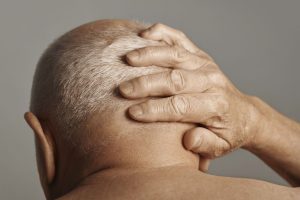Man diagnosed with dementia soon after developing ‘trich’ habit

Dementia: Dr Sara on benefits of being in nature
We use your sign-up to provide content in ways you’ve consented to and to improve our understanding of you. This may include adverts from us and 3rd parties based on our understanding. You can unsubscribe at any time. More info
Dementia is a lifelong condition characterised by a progressive deterioration of cognitive functions. The disease is widely viewed as a double-edged sword, as it is both distressing for patients and their loved ones. Memory loss is often the first sign of cognitive decline, but sometimes it may be accompanied by drastic behavioural changes.
Trichotillomania is widely considered a form of obsessive-compulsive behaviour, which tends to develop at a young age and risks becoming a lifelong complication in some cases.
The NHS explains: “Trichotillomania – also known as trich – is when someone cannot resist the urge to pull out their hair.
“They may pull out the hair on their head or in other places, such as their eyebrows or eyelashes.”
The eventual outcome of this is noticeable patchy hair loss, shortened, thinned hair or bald areas on the scalp.

Though the condition is more common in teenagers and young adults, and reports have been made of hair-pulling in elderly people with dementia.
A case study published in the journal Dementia Neuropsychology in 2011, reported on the case of an 87-year-old who frequently pulled out his hair.
The report stated that “Trichotillomania seems to be related to a form of preservation associated with dementia”.
The patient was examined after family members noticed abnormal behaviours including loss of autonomy, neglect of hygiene, abandonment of personal interests, and intensive apathy.
After the patient was referred to a dementia outpatient division, he began showing signs of progressive cognitive deterioration, mainly memory impairment and executive dysfunction.
The report stated: “The findings, in this case, suggest the abnormality involving white matter in the pathogenesis of Trichotillomania, may constitute a defect in connectivity [in the brain].”
The patient was later diagnosed with Binswanger’s disease, a type of vascular dementia and depression, for which he received appropriate medical treatment.
In this disease, widespread microscopic areas of damage can be found deep inside the layers of white matter in the brain.

A similar study, published in the International Journal of Trichology, established behavioural patterns in patients suffering from frontotemporal dementia.
In fact, the report stated that this form of dementia “often exists with co-morbid obsessions and compulsions in up to 80 percent of the patients”.
The report went on to describe the act of hair plucking as “a rare manifestation of FTD, and […] a poorly evaluated symptom in this condition”.
Trichotillomania is widely viewed in the medical field as a means of coping with stress and anxiety, which are common afflictions in patients suffering from neurodegenerative diseases.

A report in the Advocate suggests that a possible cause of hair pulling in dementia may could be trouble communicating.
It suggests that because communication with an Alzheimer’s or dementia patient is challenging, hair-pulling behaviours will erupt when that person is trying to express need or pain.
It also suggests that behaviour may be a means of gaining attention, conveying that something is wrong, or a way to distract from the discomfort of the condition.
Several studies have discussed the role of impulsivity in mental disorders, but literature on impulsivity in neurodegenerative disorders is scant.
Therefore, further research is necessary to confirm an asso
Source: Read Full Article




